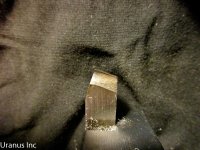farmersamm
Cast Iron
- Joined
- Feb 26, 2008
- Location
- oklahoma
Might I suggest a custom grind for 1018, and other soft gummy stuff?



Works nice for crap materials. And.............it's not some screwball grind that's popular on the net. It's capable of .020 DOC, or slightly more. Great for the finish passes. It will give the same surface finish as low as 70rpm, or up to whatever you wanna run it at. I usually run at 400rpm. The rpm range is suitable for a wide variety of material diameters.
If you have the equipment, you can run at, what I consider, insane rpm.........using carbide. But for a more down to Earth approach, this works fine.
It's not a form tool. Set it with paper under the cutter(light shining on it), while putting it against the stock. You should be relatively "flat" against the stock,, but at an angle. The tool cuts with shearing action.
You will see some lines, but the alternative is a smeary cut, that tends to catch chips, when you use carbide on gummy stuff.

Anyways........it's an alternative for cold roll, and hot roll. Ya do what ya gotta do.



Works nice for crap materials. And.............it's not some screwball grind that's popular on the net. It's capable of .020 DOC, or slightly more. Great for the finish passes. It will give the same surface finish as low as 70rpm, or up to whatever you wanna run it at. I usually run at 400rpm. The rpm range is suitable for a wide variety of material diameters.
If you have the equipment, you can run at, what I consider, insane rpm.........using carbide. But for a more down to Earth approach, this works fine.
It's not a form tool. Set it with paper under the cutter(light shining on it), while putting it against the stock. You should be relatively "flat" against the stock,, but at an angle. The tool cuts with shearing action.
You will see some lines, but the alternative is a smeary cut, that tends to catch chips, when you use carbide on gummy stuff.

Anyways........it's an alternative for cold roll, and hot roll. Ya do what ya gotta do.


